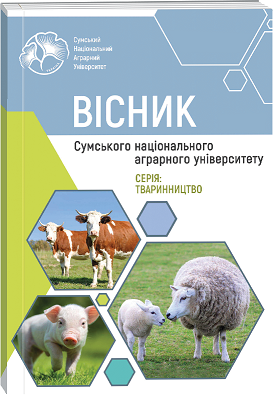STUDY OF THE EFFECT OF CHEMICAL-BASED DISINFECTANTS ON THE EGGSHELL OF POULTRY
Abstract
The paper presents the results of studying the effect of disinfectants based on chemicals on the structure and properties of poultry eggshells. Disinfectant properties and effects on poultry shells and shells of poultry eggs of preparations based on aldehyde-containing substances, compounds based on hydrogen peroxide and substances based on peracetic acid are considered. The use of disinfectants that do not affect the quality of hatching eggs and have a positive effect on the development of poultry embryos is a topical issue in poultry. Incubatory eggs of white leghorn chickens were used in the work. Eight groups of 144 eggs each were formed for the experiments. Prior to incubation, eggs were treated with solutions of substances and preparations: formaldehyde, glutaraldehyde, metacide, Virkon - S (KRKA, Slovenia), CID - 20 with the addition of peracetic acid (NOC), VIROCID with NOC, CID - 20, NOC and plant extras., VIROCID, NOC and plant extracts. Samples of shells taken after hatching of chickens were analyzed by scanning electron microscopy on the device REMMA-102 immediately after drying the solutions. Treatment of poultry eggs with disinfectants is one of the main requirements for incubation. However, the use of disinfectants with excellent bactericidal and fungicidal properties does not always lead to the desired result. In particular, preparations based on chemicals, such as aldehyde-containing compounds, reduce the protective effect of the cuticle and have carcinogenic properties against staff working in poultry farms. Peroxide-based preparations have toxic effects on developing embryos and destructive activity on the bioceramic layer of the shell. To mitigate the negative effects of drugs that contain these substances, it is recommended to add plant extracts
References
2. Bordunova O.H., Chernyavsʹka T.O., Chivanov V.D. (2007). Prohnozuvannya yakosti inkubatsiynykh yayetsʹ [Forecasting the quality of hatching eggs]. Visnyk ahrarnoyinauky, №6, 53-58 (in Ukrainian).
3. Bordunova O. H., Popsuy V.V., Astrakhantseva O.H. (2009). Nanodezinfektant ХХІ storichchya: fundamentalʹni i prykladni aspekty vykorystannya u ptakhivnytstvi [Nanodezinfectant of the XXI century: fundamental and applied aspects of use in poultry farming]. Ptakhivnytstvo: mizhvid. temat. nauk. zb., Vyp. 62, Kharkiv: IP UAAN, 6-8 (in Ukrainian).
4. Il'ina A.V., Kulikov S.N., Chalenko G.I., Gerasimova N.G., Varlamov V.P. (2008). Polucheniye i issledovaniye mono-sakharidnykh proizvodnykh nizkomolekulyarnogo khitozana [Obtaining and research of monosaccharide derivatives of low molecular weight chitosan]. Prikladnaya Biokhimiyai Mikrobiologiya, T. 44, № 5, 606-614 (in Russian).
5. Karatayev A.M., Sakhatskyy N.Y., Bezrukavaya Y.YU. (2004). Novyy dezynfektant shyrokoho spectra deystvyya [A new broad-spectrum disinfectant]. Ptakhivnytstvo: mizh vid. temat. nauk. zb. Instytut ptakhivnytstva UAAN. Kharkiv, Vyp. 53, 572(in Ukrainian).
6. Tret'yakova A.D. (1988). Veterinarnyye preparaty: spravochnik [Veterinary drugs: a reference book]. M. :Kolos, 346 (in Russian).
7. Brake, J., Walsh, T.J., Benton, C.E. Jr., Petitte, J.N., Meijerhof, R., Peñalva, G. 1997. Egg handling and storage. Poult. Sci. Issue (76). P. 144-151.
8. Cheng M. Visible-light-assisted degradation of dye pollutants over Fe(III)-loaded resin in the presence of H2O2 at neutral pH values / M. Cheng, Ma J. Li, Y. Huang, J. Zhao [et al.] // Environ. Sci. Technol. – 2004.-38.-Р. 1569 –1575.
9. Chii Shang. Repression of photoreactivation and dark repair of coliform bacteria by TiO2-modified UV-C disinfection / Chii Shang, Lok Man Cheung, Chiu-Man Ho, Minzhen Zeng // Applied Catalysis B: Environmental.- 2009.-V. 89, Issues 3-4.- P.- 536-542.
10. Elmezayyen, A.S. and Reicha, F.M. (2015). Preparation of Chitosan Copper Complexes: Molecular Dynamic Studies of Chitosanand Chitosan Copper Complexes. Open Journal of Applied Sciences, 5, 415-427.
11. Hernandez-Hernandez A. Identification of some active proteins in the process of hen eggshell formation / A. Hernandez-Hernandez, J. Gomez-Morales, A. B. Rodrіguez-Navarro, J. Gautron [et al.] // Cryst. Growth Des. - 2008. -V.8.-P.-4330-4339.
12. Herruzo R. Efficacy of a new peracetic acid-based disinfectant agent (‘Adaspor® ready to use’) / R. Herruzo, M.J. Vizcaino, I. Herruzo // Journal of Hospital Infection, Volume 74, Issue 2, February 2010, Pages 192-193
13. Merianos J. J. (2001). Surface-Active Agents. Disinfection, sterilization and preservation. Ed. by S.S. Block. New York: Lippincott Williams & Wilkins, 283-321.
14. Russel A. D. (2001) Principles of Antimicrobial activity and resistance. Part II: Fundamental Principles of Activity. Disinfection, sterilization and preservation. Ed. by S.S. Block. New - York: Lippincott Williams & Wilkins, 31-57.
15. Samuel P. Davis (ed.) (2011). Chitosan: Manufacture, Properties, and Usage. Nova Science Publishers, 507
16. Xian De li (2009). Effect of combination of chitosan coating and irradiation on physicochemical and functional properties of chicken egg during room-temperature storage. Radiation Physics and Chemistry, Vol. 78,Is. 7-8, 589-591.

 ISSN
ISSN  ISSN
ISSN 


